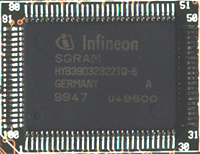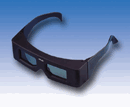Of the GeForce cards that have come into the lab, we have only seen two companies improve upon the reference design sent out by NVIDIA. The first card is the SDR based ELSA ERAZOR X which chose to use a proprietary design in order to produce a NLX form factor card. The other cards that we have seen not using the reference design are the V6x00 series cards made by ASUS (with exception to the initially launched V6600 SDRAM), making the ASUS V6800 Deluxe the first DDR card we have seen that does not utilize the run-of-the-mill design. While the choice to use a non-reference board in the case of the ELSA was for space reasons, ASUS chose not to use the reference design so that additional features could be added to the card. As seen in the V6600 Deluxe SDR card, ASUS was able to fit in advanced features such as hardware monitoring, video capture and output functions, and built in VR by using their own design. The shocking thing is how versatile this design is: as with the reference SDR and DDR board designs, there is very little difference between the actual layout of the SDR V6600 and the DDR V6800. Holding the cards side to side, the only noticeable difference between the two are the layout of the DDR SGRAM chips and a few extra capacitors that lie next to each DDR SGRAM chip. Herein lies the beauty of DDR board from the manufacturer's perspective: companies can produce almost the exact same board design for both SDR and DDR cards. The processor is not different, the card layout is not different, the cooling methods are not different; the only difference lies in the DDR RAM itself, and what a big difference it is.
DDR SGRAM stands for Double
Data Rate SGRAM and has been called the next big step in graphic card design.
As many of you know, DDR RAM can be written to on both the rising and the falling
edges of the clock cycle, resulting in double data rate. This effectively allows
the RAM to write twice per memory clock cycle, resulting in very high memory
clock speeds (NVIDIA suggests a speed of 300 MHz, resulting from 150 MHz RAM
chips being written to twice in the clock cycle). SDR RAM, standing for Single
Data Rate RAM, can only write on the rising side of the clock cycle and thus
cannot achieve as high clock speeds (the NVIDIA recommended speed here is 166
MHz). Some originally thought that this increased memory clock speed would not
result in a large performance gain at lower resolutions because the memory would
not be utilized at these resolutions; however this does not tend to be the case
as long the resolution is above 640x480. By using eight 4 MB DDR SGRAM chips
arranged on the front and back of the card, ASUS was able to obtain a significant performance increase over the SDR based cards. As with all DDR
cards coming into the lab, the ASUS V6800 Deluxe uses Infineon 6 ns chips. While
rated at 166 MHz and providing a theoretical yield of 333 MHz, ASUS used NVIDIA's
recommended 300 MHz clock speed which leaves the chips running at 150 MHz. All
the DDR cards that we have seen use the Infineon DDR SGRAM chips due to the
fact that Infineon (manufactured by SIEMENS) is the only company that currently
produces a large volume of DDR SGRAM chips for use in GeForce based cards. Not
only is the brand the same in every DDR card so far, but so have the SGRAM speeds:
all rated at 6 ns. The reason for this is because Infineon does not currently
make anything faster than 6 ns (166 MHz) DDR SGRAM chips; however, their current
plans call for 5.5 ns (183 MHz) and 5 ns (200 MHz) to be produced soon.
a significant performance increase over the SDR based cards. As with all DDR
cards coming into the lab, the ASUS V6800 Deluxe uses Infineon 6 ns chips. While
rated at 166 MHz and providing a theoretical yield of 333 MHz, ASUS used NVIDIA's
recommended 300 MHz clock speed which leaves the chips running at 150 MHz. All
the DDR cards that we have seen use the Infineon DDR SGRAM chips due to the
fact that Infineon (manufactured by SIEMENS) is the only company that currently
produces a large volume of DDR SGRAM chips for use in GeForce based cards. Not
only is the brand the same in every DDR card so far, but so have the SGRAM speeds:
all rated at 6 ns. The reason for this is because Infineon does not currently
make anything faster than 6 ns (166 MHz) DDR SGRAM chips; however, their current
plans call for 5.5 ns (183 MHz) and 5 ns (200 MHz) to be produced soon.
The GeForce processor itself is cooled via ASUS's hardware monitoring fan. The fan is stuck to the chip via a very thoroughly applied layer of thermal grease and efficiently cools the processor even when pushed to the max. Hardware monitoring is made possible through the Winbond W8371D chip which not only monitors the fan RPM but also keeps a watch on the chip temperature and voltage.
Due to the fact that the video capture and VR features of the V6800 Deluxe are identical to those of the V6600 Deluxe card review earlier, here is an except from the V6600 Deluxe review that focuses in on the video-in, video-out, and VR features of the card:
Now comes the real icing on the cake: the S-Video in and out features as well as composite out. The S-Video out features of the V6600 Deluxe are controlled by one of the best video-out controllers available: the Chrontel 7005. This is essentially the same chip that received such high ratings in our Picture This: TV-Output Comparison with a few additional features, such as enhanced text sharpness. This chip provides the V6600 Deluxe with a very clear and crisp display output via the included S-Video cable. Even using the composite output, image quality is nothing to be ashamed of, even if it is still on an older television. The S-Video in functions of the V6600 Deluxe are controlled by the Philips SAA7113A video input processor, a chip that we have yet to see. The quality of this chip is described in the following section. One thing to be noted is the lack of a composite in connection. While all new video devices come with S-Video standard, the V6600 Deluxe leaves users of older technology in the dust and clinging to their Voodoo 3500 cards.
Finally, there lies yet another feature of the card that gives the V6600 Deluxe
a bit of additional oomph; oomph which is provided by the built-in VR  plug
and included glasses. Coming out from what appears to be a headphone jack on
the video card lies the ability to see OpenGL and D3D games in 3D mode. Plugging
in the included glasses causes the polarized lenses of the glasses to turn on
and off at a quick rate, almost like you are seeing everything with flicker.
This technology, which has been around the gaming world for quite some time
now but just recently found its way into the mainstream PC game market, works
by fooling the eye into seeing depth. This is accomplished by rendering alternating
frames in a game during each refresh cycle of the monitor. The glasses work
in conjunction with this technology in order to match each frame to a separate
eye. This is done using a polarizing effect. When electricity is passed through
a thin layer of a semitransparent polarized substance that is sandwiched between
two pieces of glass, the polarized part becomes darker. This lightening and
darkening of the glass occurs in synchronization with the monitor refresh to
allow only one eye to see each frame. For example, frame 1 is rendered for the
left eye a bit to the left side of the screen and viewed through the transparent
left lens. Then, the second frame in the game placed on the right side of the
screen while the left lens of the glasses go dark. This works in the same way
that normal depth perception is formed, as your eyes (which are set apart) do
this naturally. To the onlooker without glasses, the game in question looks
like two pictures overlapped on one another. To the person viewing through the
glasses, the effect is 3D: looking almost like images and text are jumping out
at you.
plug
and included glasses. Coming out from what appears to be a headphone jack on
the video card lies the ability to see OpenGL and D3D games in 3D mode. Plugging
in the included glasses causes the polarized lenses of the glasses to turn on
and off at a quick rate, almost like you are seeing everything with flicker.
This technology, which has been around the gaming world for quite some time
now but just recently found its way into the mainstream PC game market, works
by fooling the eye into seeing depth. This is accomplished by rendering alternating
frames in a game during each refresh cycle of the monitor. The glasses work
in conjunction with this technology in order to match each frame to a separate
eye. This is done using a polarizing effect. When electricity is passed through
a thin layer of a semitransparent polarized substance that is sandwiched between
two pieces of glass, the polarized part becomes darker. This lightening and
darkening of the glass occurs in synchronization with the monitor refresh to
allow only one eye to see each frame. For example, frame 1 is rendered for the
left eye a bit to the left side of the screen and viewed through the transparent
left lens. Then, the second frame in the game placed on the right side of the
screen while the left lens of the glasses go dark. This works in the same way
that normal depth perception is formed, as your eyes (which are set apart) do
this naturally. To the onlooker without glasses, the game in question looks
like two pictures overlapped on one another. To the person viewing through the
glasses, the effect is 3D: looking almost like images and text are jumping out
at you.
 Not a new weapon, just VR without the glasses. |












0 Comments
View All Comments